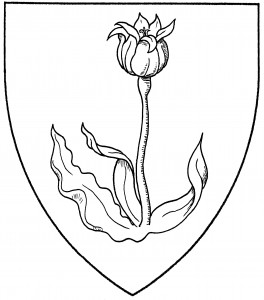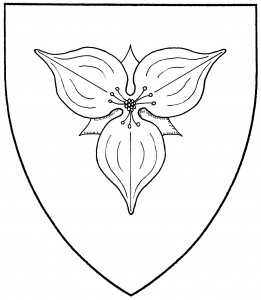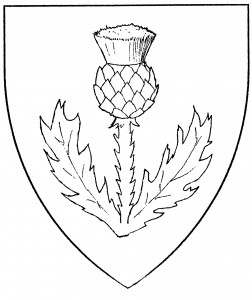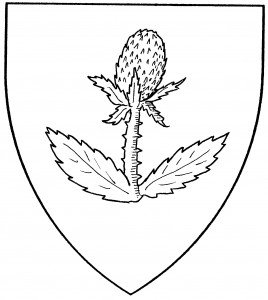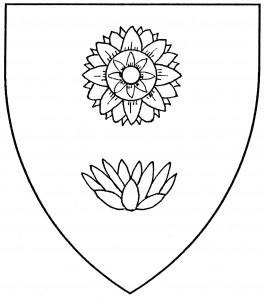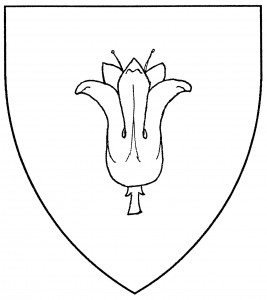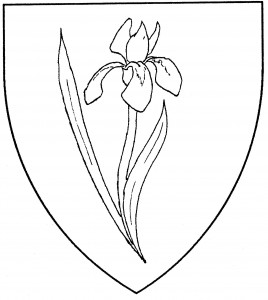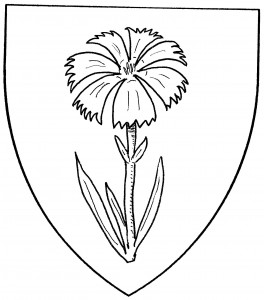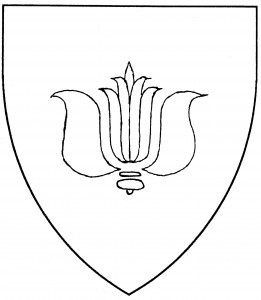
Rose (Period)
The rose is a beautiful flower, the most frequently used flower in heraldry. It is also one of the oldest, dating from the earliest heraldry in the arms of Darcy, c.1255 [Asp2 137]. Its standard heraldic form is somewhat stylized: shown affronty, with five petals separated by barbs, and central seeds. The barbing and seeding may be of a different tincture than the rest of the rose; when blazoned “barbed and seeded proper”, the barbs are green, the seeds gold. In Society heraldry, a “rose proper” is gules, barbed vert, seeded Or.
Early heralds made no distinction between heraldic roses and cinquefoils, considering both the blazons and emblazons interchangeable (as in the cadet arms of the Darcy family through the 14th Century). They are thus negligibly different in Society armory. Period heraldry has rare instances of four-petaled or six-petaled roses (e.g., the arms of Rosenberger, 1605 [Siebmacher 215]); these variants are likewise negligibly different in Society armory, and indeed are often left unblazoned.
Roses may be slipped and leaved; the serrated leaves and thorny stems of nature are here employed. Examples of roses slipped and leaved are more prevalent on the Continent than in England: e.g., the arms of Güttingen, c.1340 [Zurich 55]. Note that “roses slipped and leaved” are distinguished, by blazon and heraldic difference, from “rose branches flowered”.
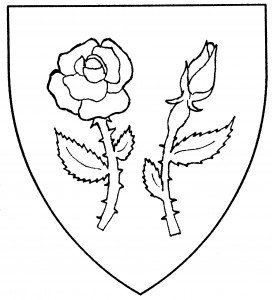
“Garden rose” slipped and leaved (SFPP); garden rosebud slipped and leaved (Disallowed)
For several years, Society blazons distinguished between the stylized rose of heraldry and the “garden rose”, depicted as found in nature: seen in side view, the petals overlapping and slightly spread. (The illustration shows a garden rose slipped and leaved.) This distinction is no longer made: all roses, be they heraldic or natural, are now blazoned simply as “roses” – with the understanding that they may all be legitimately drawn in the heraldic form. If the emblazon is submitted with a garden rose, however – seen from the side – it’s considered a step from period practice. Moreover, a naturalistic rose may not be blazoned “proper”, as roses in nature come in many colors. (The exception had been the “Damask rose proper”, which was treated as pink. This variant is no longer permitted, as being too naturalistic for medieval heraldry.)
A more specific variant of the garden rose was the “garden rosebud”, depicted with the petals closed, before the flower has fully bloomed. (The illustration shows a garden rosebud slipped and leaved.) This rose variant is no longer permitted in Society armory.
A “double rose” is an heraldic rose charged with another. When the inner petals are the same tincture as the outer petals, the double rose is treated as an artistic variation of the standard heraldic rose (indeed, the fact that the rose is doubled is currently left unblazoned), with no difference granted. When the inner and outer petals are of different tinctures, the outer petals are blazoned first: i.e., “a double rose gules and argent” and “a rose gules charged with a rose argent” are equivalent blazons.
A “rose en soleil” is shown with solar rays, alternating straight and wavy, issuant from its edges; this was a badge of Edward IV, d.1483 [HB 97].
In English cadency, the rose is the brisure of the seventh son. In the War of the Roses, the white rose was the badge of the House of York, and the red rose the badge of the House of Lancaster; roses of those tinctures may not be used in Society armory when the submitter’s name includes “of York” or “of Lancaster”, respectively. The Tudor rose, combining the York and Lancaster roses (in any of several specific ways, such as impaled), is prohibited from Society use. Likewise, the crowned rose is an English Royal badge, and so not registerable in the Society.
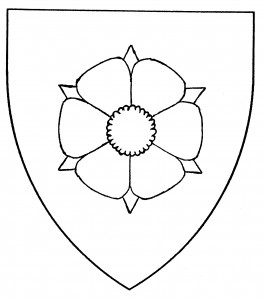
Kendall flower (Disallowed)
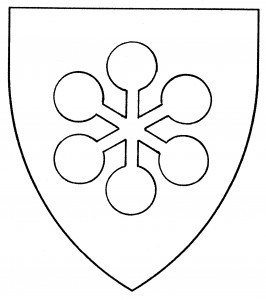
Mamluk rosette (Disallowed)
Of rose variants unique to the Society, the most common is the “Kendal flower proper”: a simplified rose of six petals, alternately argent and gules, barbed Or, seeded vert. This form was once disallowed, as being a variant of the Tudor rose; while the motif is now registerable, it’s no longer blazoned by the Society-specific term. There is also the “Mamluk rosette”, a motif found in Arabic art, which is essentially a stylized sexfoil; it likewise has been disallowed, as having been too uncommon in period to be compatible with Society armory.
For related charges, see foil.
The Legion of Courtesy, of Caid, bears: A rose Or barbed and seeded vert.
Alys of the Midnight Rose bears: Or, a rose slipped and leaved azure.
Jonas Aquilian bears: Azure, three roses argent.
Sonja of Atenveldt bears: Per chevron azure and sable, a rose gules en soleil argent.
Aurelia of Ashton bears: Azure fretty argent, on an open book Or a damask rosebud slipped and leaved proper.
Kaidu ibn Yesugai bears: Azure, on a bend sinister Or between two Mamluk rosettes argent, an arrow inverted sable fletched gules.
Gerhard Kendal of Westmoreland bears: Or, a lizard tergiant displayed vert between in fess two Kendal flowers proper.
